Linear transformers provide a consistent voltage conversion with minimal losses, ideal for applications demanding steady power supply, while switching transformers operate with rapid on-off switching to achieve high efficiency and compact size in power electronics. Explore the rest of the article to understand which transformer best suits your specific needs.
Comparison Table
| Feature | Linear Transformer | Switching Transformer |
|---|---|---|
| Architecture | Applies kernel methods to approximate attention linearly | Uses multiple experts and routes tokens dynamically |
| Attention Complexity | O(n) | Varies, often O(m) where m << n (via routing) |
| Scalability | Good for long sequences with reduced memory | Highly scalable by activating sparse experts per token |
| Model Size | Typically smaller and efficient | Potentially very large with many experts |
| Routing Mechanism | No | Yes, dynamic token-to-expert routing |
| Use Cases | Long sequence modeling in resource constrained environments | Massive scale models, sparse compute optimization |
| Training Complexity | Moderate, simpler optimization | Complex due to routing and expert balancing |
Introduction to Transformers
Transformers are essential electrical devices that transfer electrical energy between circuits through electromagnetic induction, enabling voltage regulation and efficient power distribution. Linear transformers provide a constant output voltage proportional to the input, ideal for sensitive electronic applications requiring stable current flow. Switching transformers operate at high frequencies with rapid on-off cycling, enhancing energy efficiency and size reduction in power supplies, making them suited for modern, compact electronic devices.
What is a Linear Transformer?
A linear transformer is a type of electrical transformer designed to operate with a linear relationship between input and output voltage, ensuring minimal distortion of the waveform. It typically consists of a core and coil assembly that transfers power through electromagnetic induction while maintaining signal fidelity in applications like audio amplifiers and sensitive instrumentation. In contrast, switching transformers use high-frequency switching currents to achieve voltage regulation, resulting in compact size but potential waveform distortion.
What is a Switching Transformer?
A switching transformer is a type of transformer used in switched-mode power supplies (SMPS) that operates at high frequencies to efficiently convert electrical energy. Unlike linear transformers, switching transformers regulate voltage by rapidly switching the input current on and off, enabling smaller size and lighter weight while maintaining high efficiency. Your electronic devices benefit from switching transformers as they provide stable power with reduced energy loss and heat generation.
Key Differences Between Linear and Switching Transformers
Linear transformers regulate voltage through continuous magnetic flux with minimal noise, offering high efficiency in low-power applications and simplicity in design. Switching transformers use high-frequency switching to transfer energy, enabling compact size, lighter weight, and improved efficiency in high-power and variable load scenarios. Your choice depends on application requirements, balancing factors like efficiency, size, noise level, and complexity.
Efficiency Comparison
Linear transformers often provide higher efficiency in low-power applications due to minimal switching losses and simpler construction, making them ideal for audio and signal processing. Switching transformers excel in high-frequency environments where their ability to rapidly switch allows for smaller size and better energy conversion efficiency, especially in power supplies. Efficiency in switching transformers varies with switching frequency and load conditions, often surpassing linear transformers in modern power electronics.
Size and Weight Considerations
Linear transformers are generally larger and heavier due to their iron core and windings designed for continuous current, making them less suitable for compact or portable applications. Switching transformers use ferrite cores and operate at higher frequencies, allowing them to be smaller and lighter while maintaining efficiency. If minimizing your device's size and weight is critical, switching transformers offer a significant advantage over traditional linear transformers.
Applications of Linear Transformers
Linear transformers are widely used in applications requiring smooth, continuous voltage regulation and precise current control, such as audio equipment, laboratory power supplies, and sensitive instrumentation. They are essential in low-frequency analog signal processing where minimal electromagnetic interference and low noise are critical. Their capability to provide stable output under varying load conditions makes them suitable for medical devices and precision measurement systems.
Applications of Switching Transformers
Switching transformers are widely used in power supply circuits, especially in switch-mode power supplies (SMPS), where their efficiency and compact size are critical. Their applications span consumer electronics, telecommunications, and industrial automation, providing voltage regulation and isolation in high-frequency operations. You can rely on switching transformers for precise energy transfer in devices requiring fast switching and minimal energy loss.
Cost Analysis: Linear vs Switching Transformers
Linear transformers typically have higher material costs due to larger cores and extensive copper windings, resulting in increased size and weight. Switching transformers, used in switch-mode power supplies, are more cost-efficient as they operate at higher frequencies, allowing smaller core sizes and reduced copper usage, which lowers manufacturing expenses. Choosing a switching transformer can optimize Your budget by minimizing both component costs and energy losses.
Choosing the Right Transformer for Your Needs
Selecting between a linear transformer and a switching transformer depends on your application's efficiency requirements and size constraints. Linear transformers offer low noise and precise voltage regulation ideal for audio and medical devices, while switching transformers provide higher efficiency and compact size suited for power supplies and portable electronics. Consider factors like heat dissipation, electromagnetic interference, and load stability to ensure optimal performance for your specific electrical needs.
linear transformer vs switching transformer Infographic

 solderic.com
solderic.com